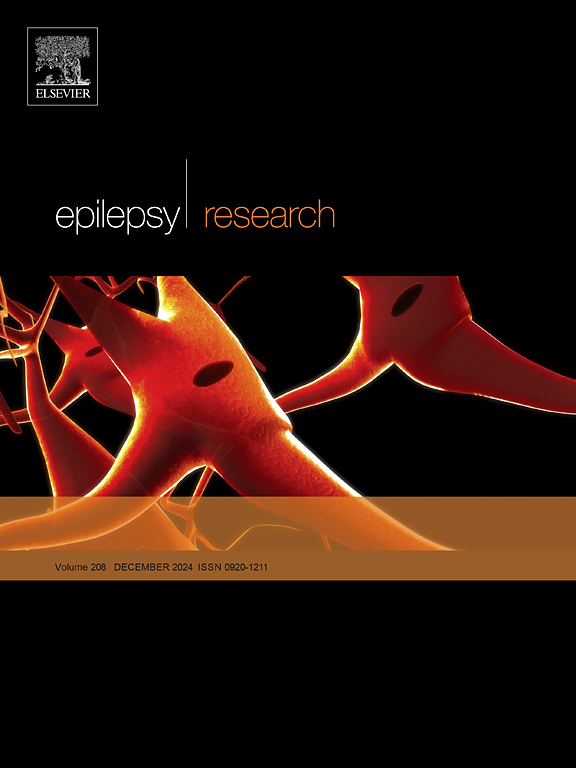Exploring metabolic biomarkers and pathways in pharmacoresistant epilepsy: A systematic review
IF 2
4区 医学
Q3 CLINICAL NEUROLOGY
引用次数: 0
Abstract
Drug-resistant epilepsy (DRE) is characterized by the failure to attain sustained seizure freedom despite adequate trials of two antiseizure medication (ASM) regimens that are well tolerated and appropriately chosen and administered, either as monotherapies or in combination. Despite being a cornerstone of epilepsy treatment, ASMs are ineffective in achieving seizure remission in nearly one-third of patients, who are consequently classified as having DRE. This systematic review aims to determine potential metabolic biomarkers and pathways linked to DRE, which could inform personalized treatment and optimize therapeutic outcomes. A comprehensive search of databases, namely Medline, Web of Science and the Cochrane Central Register of Controlled Trials (CENTRAL) based on predefined inclusion and exclusion criteria yielded 29 eligible studies after full-text screening. The risk of bias from these studies was reviewed using the Office of Health Assessment and Translation (OHAT) risk of bias rating tool. Key information, including study groups, sample size, model types, and main findings were tabulated. Several metabolites were identified, including amino acids (glycine, glutamate, isoleucine), organic acids (lactate), and glucose, which may serve as potential biomarkers for DRE. MetaboAnalyst 6.0 pathway analysis identified the alanine, aspartate and glutamate metabolism, as well as phenylalanine, tyrosine and tryptophan biosynthesis pathways, emerged with significant impact score (≥0.5, p < 0.05). The findings highlight the promising role of these metabolites and pathways as predictive biomarkers for DRE and potential therapeutic targets for novel drug development.
探索抗药癫痫的代谢生物标志物和途径:系统综述
耐药癫痫(DRE)的特点是,尽管对两种抗癫痫药物(ASM)方案进行了充分的试验,但仍未能实现持续的癫痫发作自由,这两种抗癫痫药物(ASM)方案具有良好的耐受性,并且可以作为单一疗法或联合疗法进行适当的选择和施用。尽管asm是癫痫治疗的基石,但在近三分之一的患者中,asm对癫痫发作的缓解是无效的,因此这些患者被归类为DRE。本系统综述旨在确定与DRE相关的潜在代谢生物标志物和途径,从而为个性化治疗提供信息并优化治疗结果。综合检索数据库,即Medline, Web of Science和Cochrane Central Register of Controlled Trials (Central),基于预定义的纳入和排除标准,在全文筛选后获得29项符合条件的研究。使用健康评估和翻译办公室(OHAT)偏倚风险评级工具对这些研究的偏倚风险进行了审查。关键信息,包括研究组、样本量、模型类型和主要发现被制成表格。鉴定出几种代谢物,包括氨基酸(甘氨酸、谷氨酸、异亮氨酸)、有机酸(乳酸)和葡萄糖,它们可能作为DRE的潜在生物标志物。MetaboAnalyst 6.0通路分析发现丙氨酸、天冬氨酸和谷氨酸代谢,以及苯丙氨酸、酪氨酸和色氨酸的生物合成通路,出现显著影响评分(≥0.5,p <; 0.05)。这些发现强调了这些代谢物和途径作为DRE的预测性生物标志物和新药开发的潜在治疗靶点的有希望的作用。
本文章由计算机程序翻译,如有差异,请以英文原文为准。
求助全文
约1分钟内获得全文
求助全文
来源期刊

Epilepsy Research
医学-临床神经学
CiteScore
0.10
自引率
4.50%
发文量
143
审稿时长
62 days
期刊介绍:
Epilepsy Research provides for publication of high quality articles in both basic and clinical epilepsy research, with a special emphasis on translational research that ultimately relates to epilepsy as a human condition. The journal is intended to provide a forum for reporting the best and most rigorous epilepsy research from all disciplines ranging from biophysics and molecular biology to epidemiological and psychosocial research. As such the journal will publish original papers relevant to epilepsy from any scientific discipline and also studies of a multidisciplinary nature. Clinical and experimental research papers adopting fresh conceptual approaches to the study of epilepsy and its treatment are encouraged. The overriding criteria for publication are novelty, significant clinical or experimental relevance, and interest to a multidisciplinary audience in the broad arena of epilepsy. Review articles focused on any topic of epilepsy research will also be considered, but only if they present an exceptionally clear synthesis of current knowledge and future directions of a research area, based on a critical assessment of the available data or on hypotheses that are likely to stimulate more critical thinking and further advances in an area of epilepsy research.
 求助内容:
求助内容: 应助结果提醒方式:
应助结果提醒方式:


